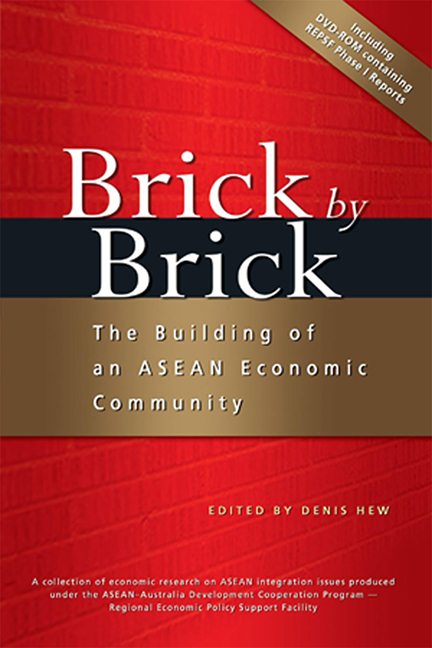Book contents
- Frontmatter
- Contents
- Foreword by Ong Keng Yong
- Foreword by Bruce Davis
- Acknowledgements by Academic Editor
- Acknowledgements by Technical Director REPSF
- The Contributors
- The Regional Economic Policy Support Facility
- 1 Introduction: Brick by Brick — The Building of an ASEAN Economic Community
- 2 What is a Single Market? An Application to the Case of ASEAN
- 3 The Challenge of Economic Integration for Transitional Economies of Southeast Asia
- 4 A Review of Regional Tariffs and Trade in the ASEAN Priority Goods Sectors
- 5 Non-tariff Barriers to Trade in the ASEAN Priority Goods Sectors
- 6 An Assessment of ASEAN's Priority Sectors for Fast-track Integration
- 7 ASEAN Tax Regimes: Impediment or Pathway to Greater Integration
- 8 An Overview of the Foreign Direct Investment Jurisprudence
- 9 ASEAN's FTA Negotiations with Dialogue Partners:Identifying Strengths and Weaknesses in Business Opportunities
- 10 Conclusion: Towards an ASEAN Economic Community by 2015
- Index
- Contents of Accompanying CD-ROM: AADCP-REPSF Phase I Research Program
1 - Introduction: Brick by Brick — The Building of an ASEAN Economic Community
Published online by Cambridge University Press: 21 October 2015
- Frontmatter
- Contents
- Foreword by Ong Keng Yong
- Foreword by Bruce Davis
- Acknowledgements by Academic Editor
- Acknowledgements by Technical Director REPSF
- The Contributors
- The Regional Economic Policy Support Facility
- 1 Introduction: Brick by Brick — The Building of an ASEAN Economic Community
- 2 What is a Single Market? An Application to the Case of ASEAN
- 3 The Challenge of Economic Integration for Transitional Economies of Southeast Asia
- 4 A Review of Regional Tariffs and Trade in the ASEAN Priority Goods Sectors
- 5 Non-tariff Barriers to Trade in the ASEAN Priority Goods Sectors
- 6 An Assessment of ASEAN's Priority Sectors for Fast-track Integration
- 7 ASEAN Tax Regimes: Impediment or Pathway to Greater Integration
- 8 An Overview of the Foreign Direct Investment Jurisprudence
- 9 ASEAN's FTA Negotiations with Dialogue Partners:Identifying Strengths and Weaknesses in Business Opportunities
- 10 Conclusion: Towards an ASEAN Economic Community by 2015
- Index
- Contents of Accompanying CD-ROM: AADCP-REPSF Phase I Research Program
Summary
Introduction
The Association of Southeast Asian Nations (ASEAN) is one of the world's most successful regional organizations. Established on 8 August 1967, ASEAN consists of ten member countries, namely, Brunei, Cambodia, Indonesia, Laos, Malaysia, Myanmar, the Philippines, Singapore, Thailand, and Vietnam.
ASEAN countries combined constitute a population of about 567 million, spanning a total area of 4.5 million square kilometres. In 2006, ASEAN generated a combined gross domestic product of US$1.07 trillion and total trade of US$1.44 trillion, accounting for more than a quarter of Asia's total exports and imports.
Since its inception four decades ago, ASEAN has successfully managed to foster closer political and security cooperation, creating a peaceful and stable region. As a result, ASEAN, especially its original five members (ASEAN-5), i.e., Indonesia, Malaysia, the Philippines, Singapore, and Thailand, has enjoyed impressive economic growth, reduced poverty and improved living standards over the past three decades.
Although many ASEAN countries were severely affected by the 1997 Asian financial crisis, their economies have recovered ten years on. However, during this time the region has begun to face stiff competition from China, particularly in attracting foreign direct investments (FDIs). This has raised serious concerns among ASEAN policy-makers about the longer term economic development and sustainability of this region.
Against this backdrop, ASEAN leaders agreed to embark on a bold project to integrate their economies and establish an ASEAN Economic Community. This ambitious project will clearly require a significantly higher level of economic integration than that which exists today.
The ASEAN Economic Community
At the 2003 ASEAN Summit in Bali, Indonesia, ASEAN leaders agreed to integrate their economies by 2020 and establish an ASEAN Economic Community (AEC). The AEC is one of the three components or pillars that make up the ASEAN Community as declared by ASEAN leaders in the ASEAN Concord II (better known as the Bali Concord II). At the ASEAN Summit held in Cebu, Philippines in January 2007, the deadline to realize the AEC was brought forward by five years to 2015.
The end-goal of the AEC is the creation of a single market and production base where there is free flow of goods, services, investments, capital, and skilled labour.
- Type
- Chapter
- Information
- Brick by BrickThe Building of an ASEAN Economic Community, pp. 1 - 12Publisher: ISEAS–Yusof Ishak InstitutePrint publication year: 2007



